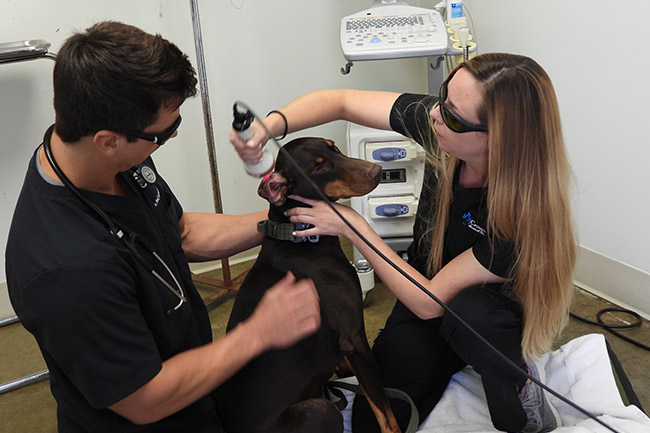Pet Laser Therapy
Laser Therapy in Moody, St. Clair County AL
Laser therapy is the use of a cold laser to treat your pet. Laser therapy can reduce pain (acute and post-operative pain), reduce inflammation, help chronic conditions and be used to treat wounds, surgical areas, dermatological problems and rehabilitating pets. Laser therapy can also provide relief to your older pet with arthritis, degenerative joint and disc disease, hip dysplasia and periodontal disease. Laser therapy treatment is safe, painless and fast and does not require anesthesia.
What is a Cold Laser?
A laser (an acronym for Light Amplification through Stimulated Emission of Radiation) generates straight, intense beams of light of one narrow chosen wavelength. The cold laser therapy device is hand-held, almost like a flashlight connected to its electronics with a thick flexible cable. Infra-red laser beams can penetrate the skin to a depth of about 2 inches. Low-powered lasers penetrate the skin without damaging the soft tissue underneath.
How does Laser Therapy Work?
When the laser beam hits the cells that line small arteries under the skin a chemical called nitric oxide is released that relaxes and opens the blood vessels and increases blood flow to the area. The laser energy also desensitizes local pain receptors, reducing the feeling of pain.
How long does the treatment take?
Treatment protocols are unique to each patient and condition. Therefore, treatments will vary in time, complexity and cost. For some chronic patients, multiple joints may be treated during one laser treatment session. When appropriate, laser therapy can be used as a complementary adjunct to other treatment plans.
Are there any side effects?
There are no known side effects with this treatment.
When can I expect to see an improvement? What might I see?
You may see relief in your pet after the first treatment because pain and inflammation are reduced. For some conditions, a series of treatments may be necessary before you see results due to the severity or complexity of the condition. Each pet is different, and treatments are unique for your pet’s specific needs.


